
By Esprit Heestand Saucier - University of Louisiana at Lafayette
September 30, 2012
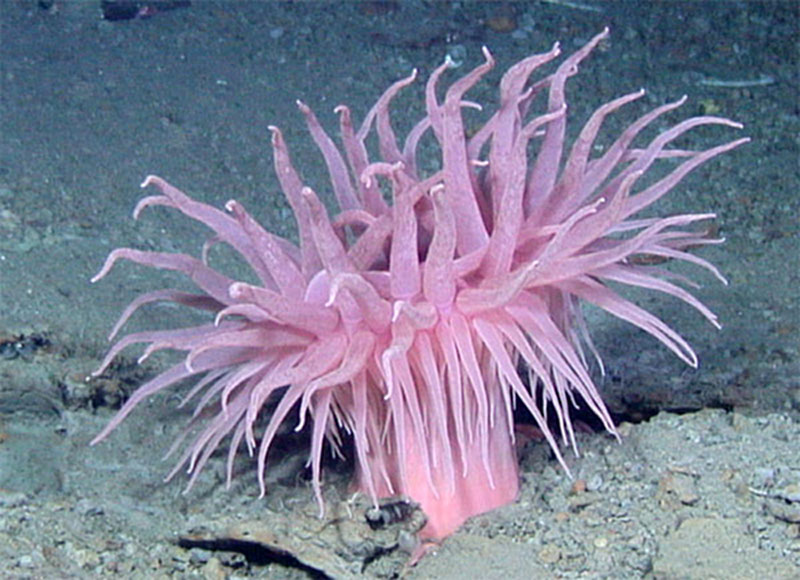
As a scientist on a research cruise, you do not always find what you are looking for. To accomplish the research goals put forth for this scientific mission (population gene flow) we had to change our target species. Due to an abundance of anemones in these canyons, and the lack of bamboo coral, we chose to collect and study anemones for this mission. Image courtesy of the Deepwater Canyons 2012 Expedition, NOAA-OER/BOEM. Download image (jpg, 117 KB).
One of the things that I find captivating about the ocean is the idea that I’m standing (or in a boat floating) on the roof of another world. Throughout the ages, man has been drawn to and inspired by this mysterious world. Based on a human’s perspective, the ocean, particularly the deep sea, is an extreme environment because of its high pressure, cold temperatures, and lack of sunlight.
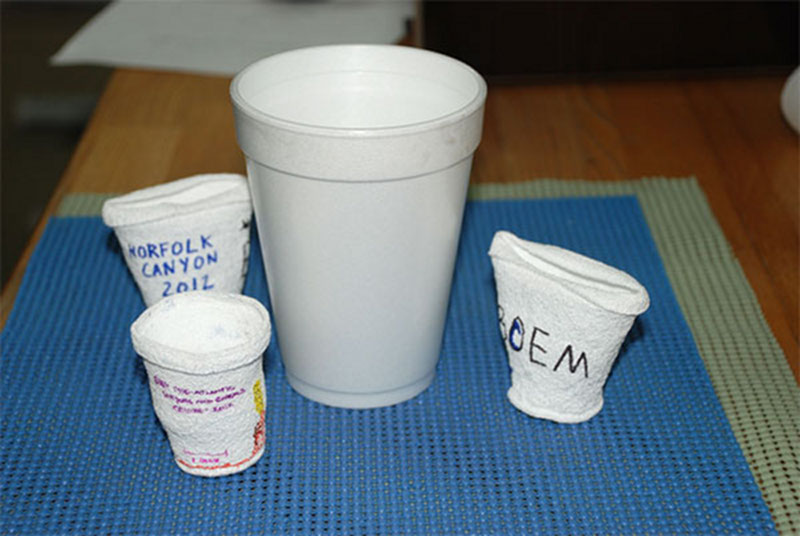
The cup in the center is a normal Styrofoam cup surrounded by cups that were colored by school children at the North Carolina Museum of Natural Science. The colored cups were sent down on the CTD to a depth of about 1,000 meters. At that depth, the pressure of the water squeezes and shrinks the cups. While we cannot survive at that depth, benthic deepwater animals thrive there. Image courtesy of the Deepwater Canyons 2012 Expedition, NOAA-OER/BOEM. Download image (jpg, 80 KB).
These factors have isolated the deep sea from exploration for many years and help explain why so little is known about the largest ecosystem on the planet when compared to terrestrial ecosystems; however, given our advances in technology, we are now able to explore to greater depths in the ocean.

Google map showing the Continental Shelf off of Virginia Beach where the Norfolk Canyon lies. Creatures that live in these deep canyons are engineered for a high-pressure, low-light environment. Image courtesy of the Deepwater Canyons 2012 Expedition, NOAA-OER/BOEM. Download image (jpg, 70 KB).
A majority of the animals found in the ocean live on the continental shelf in the top 200 meters of water or in the photic zone (the depth of water where there is enough light for photosynthesis to occur). This is also the most visible and well-known part of the ocean, although it encompasses only the top 2.7 percent of the average depth of the ocean.
It was once thought that there wasn’t any life in the deep sea, only mud and rocks. However, in the 1870s, the Challenger expedition used trawls to sample the deep sea and proved that there was life in its murky depths. In the 1960s, the development of an epibenthic sled with a much smaller mesh than trawls allowed for capture of the very small animals that live in the sediments of the ocean floor, and showed us that although there wasn’t a great abundance of animals in the deep sea, there is a much higher level of species diversity than we thought.
With the more recent advances in ocean exploration technology, such as ROVs (remotely operated vehicles) and HOVs (human occupied vehicles), we are now able to view many of these animals in situ and get a better idea of how they live and act in their natural environment.

Lights, camera, action! The Kraken II ROV used for this expedition was built for science and was equipped with all the tools needed for collecting deepwater specimens. Image courtesy of the Deepwater Canyons 2012 Expedition, NOAA-OER/BOEM. Download image (jpg, 53 KB).
Life in the deep sea can be challenging: there is very little light (if there is any at all) and very little food, and it is very cold (4°C). Much of deep sea is a broadly homogeneous environment that can be compared to vast African deserts in that it is relatively flat and covered in sediment. These areas are known as abyssal plains and have a low diversity and abundance of animals comparatively. There are some areas of relief where different kinds of animals may congregate. These topographical features can range from large rocks, such as drop stones that can get deposited in the middle of the plains by volcanoes or strong ocean-floor turbidity currents, to seamounts that rise one to several kilometers off the bottom, to underwater canyons like the ones we are exploring on this cruise.
The features change the way the current flows, speeding it up, which means more food to the animals that capture food particles suspended in the water.
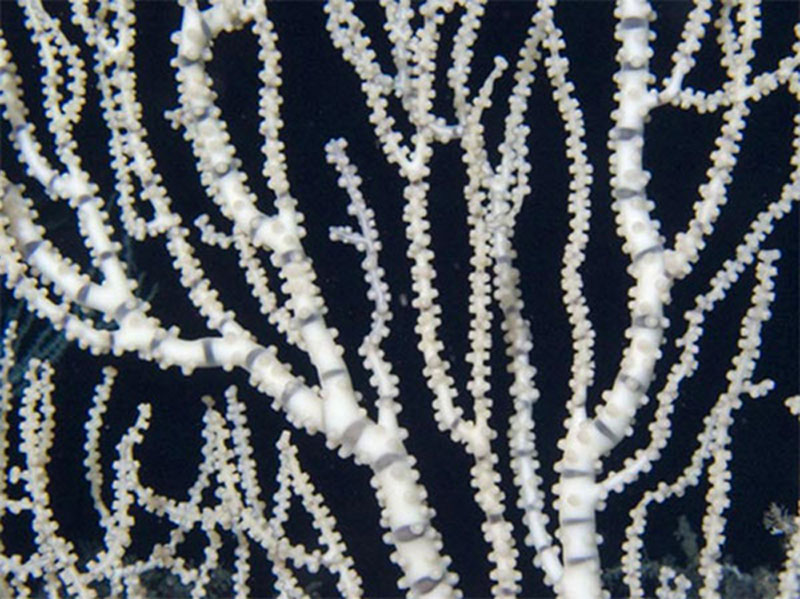
While mature bamboo corals cannot travel, they begin their lives in a free-swimming larval stage. Image courtesy of Scott C. France, Deepsea Biology Lab, University of Louisiana at Lafayette. Download image (jpg, 132 KB).
A seamount (or any other topographical feature) can act as an island oasis in the middle of a shapeless desert. While there are thousands of seamounts in the deep sea, the distance between them may seem immense to the organisms that live on them, such as sessile invertebrates like corals that are attached to the bottom and can’t move as adults. I’m interested in looking at population-level differences and species-level differences in the deep sea and I am using deep-sea bamboo corals to do this.
Bamboo corals, as their name indicates, have skeletons that look similar to a bamboo stalk, with alternating calcium carbonate internodes and proteinaceous nodes. Although they cannot travel as adults, they produce a free-swimming larval stage that can.

The anemone is gently retrieved using the Kraken II’s manipulator for collection. Once collected, the specimen is placed in a remotely controlled drawer. Four cameras on the Kraken II show different views. One is specifically set to monitor the collection activity. Image courtesy of the Deepwater Canyons 2012 Expedition, NOAA-OER/BOEM. Download image (jpg, 61 KB).
Since environmental factors in the deep sea are constant throughout the world, the limiting factor to coral larval dispersal would be suitable habitat for the larva to settle on and the life span and swimming ability of that larva. I’m interested in determining how far bamboo coral larvae can travel. Can they swim from one seamount (or canyon) to another and successfully settle? If they cannot, are the populations that live on the seamounts isolated from each other? If so, they may be evolving in isolation, leading to new species.
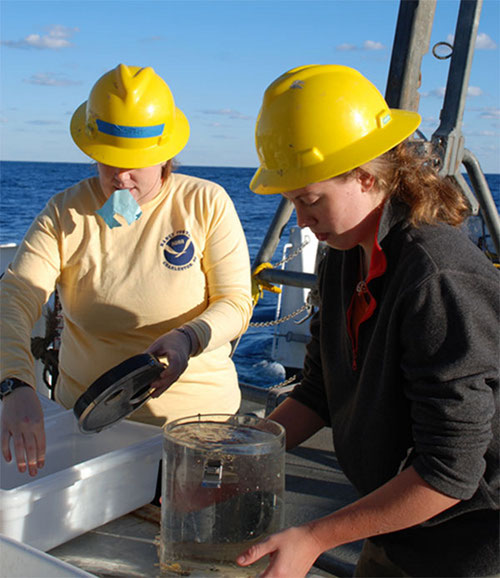
Ph.D. Candidates Esprit Heestand Saucier and Kirstin Meyer process specimens collected by the Kraken II ROV. Image courtesy of the Deepwater Canyons 2012 Expedition, NOAA-OER/BOEM. Download image (jpg, 70 KB).
The Deep Sea Biology Lab at the University of Louisiana at Lafayette under Dr. Scott C. France has already identified several species of octocorals that are genetically similar, in particular a bamboo coral from the genus Acanella that has been found in all the major oceans. I will use microsatallites, which are also used in forensic analysis and genealogical DNA testing, as genetic markers to determine the relatedness of coral colonies from one seamount to another or coral colonies from one canyon to another.
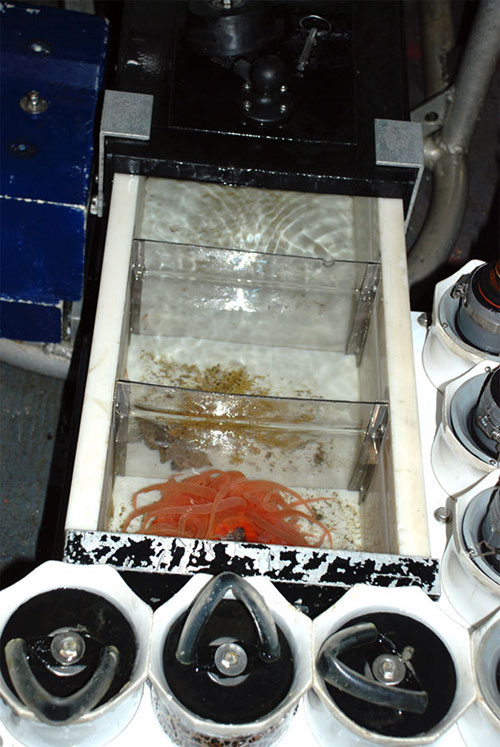
The specimens collected by the Kraken II are transferred on the deck of the NOAA Ship Nancy Foster and taken into the “wet” lab for further work. Image courtesy of the Deepwater Canyons 2012 Expedition, NOAA-OER/BOEM. Download image (jpg, 94 KB).
In the scope of this project and cruise, I am interested in determining if larvae from corals in Norfolk Canyon can travel to Baltimore Canyon and vice versa. If so, then we would be able to say that there is gene flow, or the transfer of genes from one population to another, occurring between the two canyons. If not, then the coral populations in each of the canyons are isolated from each other and there is no gene flow occurring between the corals in the two canyons.
This cruise, and others like it, will allow me to sample for bamboo corals and other cnidarians to assess their relatedness within populations and between populations. Understanding gene flow of bottom-dwelling invertebrates can be very important from an ecological standpoint. We can use microsatellites to identify unique populations of corals and set up conservation management strategies to protect them.
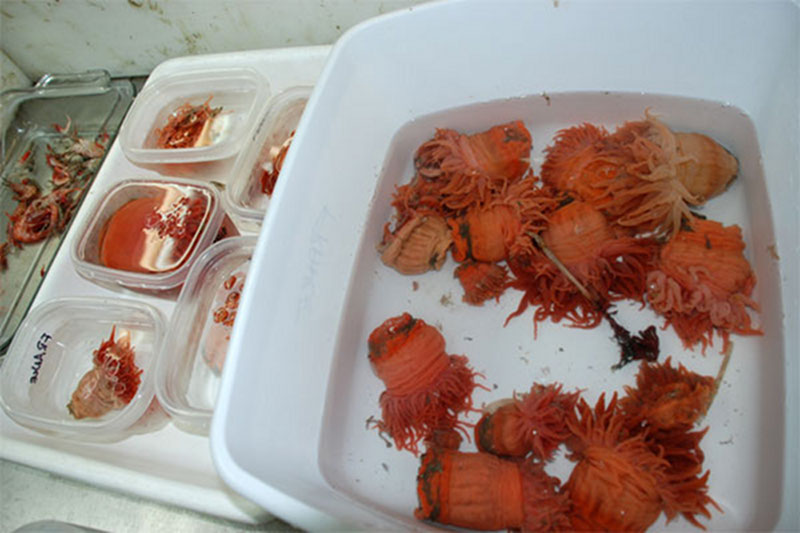
In the wet lab, anemones are sorted, labeled, photographed, and preserved for genetic analysis back at the lab. The genetic markers of these anemones will be compared to those in nearby canyons. Image courtesy of the Deepwater Canyons 2012 Expedition, NOAA-OER/BOEM. Download image (jpg, 80 KB).